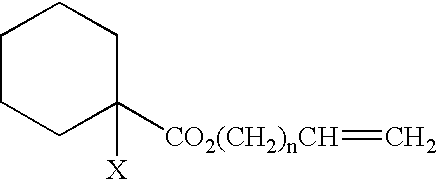Curable compositions
a composition and composition technology, applied in the field of cureable compositions, can solve the problems of difficult to produce such polymers on a commercial scale, handicapped control of polymerization reaction of acrylic polymers, and difficulty in introducing functional groups into the molecular chain terminus,
- Summary
- Abstract
- Description
- Claims
- Application Information
AI Technical Summary
Benefits of technology
Problems solved by technology
Method used
Image
Examples
production example 1
[0460]A 10-L separable flask equipped with a reflux-condenser and a stirrer was charged with CuBr (28.0 g, 0.195 mol). After nitrogen gas purging, acetonitrile (559 mL) was added and the mixture was stirred on an oil bath at 70 C for 15 minutes. Thereafter, butyl acrylate (1.00 kg), diethyl 2,5-dibromoadipate (117 g, 0.325 mol) and pentamethyldiethylenetriamine [hereinafter referred to briefly as triamine] (1.70 mL, 1.41 g, 8.14 mmol) were added and the reaction was started. Under heating at 70° C. with constant stirring, butyl acrylate (4.00 kg) was continuously added dropwise over 175 minutes. In the course of dripping butyl acrylate, triamine (8.50 mL, 7.06 g, 40.7 mol) was further added. At 370 minutes after initiation of the reaction, 1,7-octadiene (1.57 L, 1.17 kg, 7.10 mol) and triamine (20.4 mL, 16.9 g, 97.7 mmol) were added, and the whole mixture was stirred under heating at 70 C for 220 minutes.
[0461]This reaction mixture was diluted with hexane and passed through an activ...
production example 2
[0465]A 2-L separable flask equipped with a reflux-condenser and a stirrer was charged with CuBr (22.4 g, 0.156 mol), followed by nitrogen gas purging. Then, acetonitrile (112 mL) was added and the mixture was stirred on an oil bath at 70 C for 30 minutes. Thereafter, butyl acrylate (0.20 kg), methyl 2-bromopropionate (86.9 g, 0.520 mol) and pentamethyldiethylenetriamine [hereinafter referred to briefly as triamine] (0.19 mL, 0.18 g, 1.04 mmol) were added and the reaction was started. Under heating at 70° C. with constant stirring, butyl acrylate (0.80 kg) was continuously added dropwise over 150 minutes. In the course of dripping butyl acrylate, triamine (1.81 mL, 1.71 g, 9.88 mol) was further added. The whole mixture was stirred under heating at 70° C. for 230 minutes.
[0466]This reaction mixture was diluted with toluene and passed through an activated alumina column, and the volatile matter was distilled off under reduced pressure, whereby an alkenyl group-terminated polymer (poly...
example 1
[0468]One-hundred parts of the polymer [4] obtained in Production Example 1, 3 parts of pentaerythritol triacrylate [(CH2═CHCOOCH2)3CCH2OH], 50 parts of polymer [6] as plasticizer, and 100 parts of Calfine 100 (Product of Maruo Calcium) as filler were admixed under stirring. Then, 2 parts of γ-glycidoxypropyltrimethoxysilane and 1 part of Sn(IV) catalyst (dibutyltin diacetylacetonate) were added and stirred and the whole mixture was degassed and molded to give a cured product in the form of a 2 mm (approx.)-thick flat sheet and a cured product in a plano-convex form with a maximum thickness of about 5 mm on a glass sheet. Curing was effected by allowing each product in a sunlit interior environment (near a window) for 2 days and further at 50° C. for 3 days. After curing, the sheet was tested for residual tack (surface tackiness) by the finger touch method and, then, let standing outdoors. The plano-convex cured product was irradiated through the glass, immediately after curing, wit...
PUM
| Property | Measurement | Unit |
|---|---|---|
| molecular weight distribution | aaaaa | aaaaa |
| molecular weight distribution | aaaaa | aaaaa |
| temperature | aaaaa | aaaaa |
Abstract
Description
Claims
Application Information
 Login to View More
Login to View More - R&D
- Intellectual Property
- Life Sciences
- Materials
- Tech Scout
- Unparalleled Data Quality
- Higher Quality Content
- 60% Fewer Hallucinations
Browse by: Latest US Patents, China's latest patents, Technical Efficacy Thesaurus, Application Domain, Technology Topic, Popular Technical Reports.
© 2025 PatSnap. All rights reserved.Legal|Privacy policy|Modern Slavery Act Transparency Statement|Sitemap|About US| Contact US: help@patsnap.com



